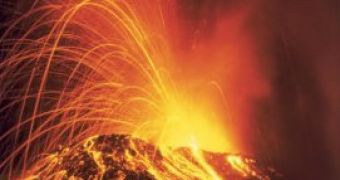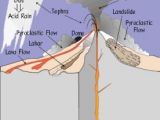The world "volcano" comes from the Roman god of fire Vulcan, the equivalent of Hephaistos in the Greek mythology. In the ancient times, people attributed to the volcanoes a supernatural personality, which was worshiped. Old Greeks believed the Earth was a floating disc over the surface of an ocean whose storms triggered earthquakes and volcanic eruptions. Anaximander (611-547 BC) believed that cold and heat turned on the volcanic eruptions. Plato (428-347 BC) supposed there was an underground river of incandescent matter that fueled the mouth of the volcanoes.
For Aristotle, disciple of Plato, the volcanic eruptions and earthquakes were the spasms of a living being called Terra. Only during the 18th century, the knowledge about volcanoes started to evolve considerably. James Hutton (1726-1797) said that in the center of the Earth was a fusion zone, the eruptions being its external manifestations. His theory proved right during the 19th century.
Now, researchers just focus on achieving the right methods of preventing the volcanic eruptions and decreasing the damages they inflict. Under the litosphere (the terrestrial crust which varies in width from 70 km under the oceans to 140 km under the continents), in the terrestrial mantle (the inner part of the Earth, located under the litosphere, with a width of 3,000 km and wrapping the nucleus), the pyrolitic rocks are found molten , in the magma stage. The huge tectonic plates, which make up the massive foundation of the continents and the bottom of the oceans, tightly float and mover over the very dense magma.
In the inner Earth, there are two zones with rocks in fusion: the outer nucleus, separated by the surface of the Earth by solid rocks, and a thin layer of partially molten rocks which separates the litosphere from astenosphere (the magma located under litosphere, on which float and move the tectonic plates).
Why do pyrolitic rocks melt? Because of the temperature, pressure, and the presence of the water, which facilitate the rocks' melting.
Volcanoes are just holes in the Earth's crust through which magma accompanied by gas and ash goes out. There are more types of volcanism, associated with the local cause of the fusion of the rocks making the terrestrial mantle. In the subduction areas (like in Andes), the cause is the presence of the fluids closed in sediments and headed into the depths while a tectonic plate slips under another.
In the distension areas, the avert of the one plate from another (like in the middle of Atlantic or the Great African Rift), leads to a pressure decrease. In the case of the intraplate volcanism, the cause is the existence of an abnormal hot spot. The hot spot remains on place, no matter the movement of the tectonic plates above them. They produce enormous amounts of magma that ascends and gush out, not depending on a weak resistance point, drilling the crust. Such a hot spot is Hawaii.
As the magma is the result of the partial fusion of the pyrolitic rocks, its composition depends on the fusion temperature. From the various minerals, the magnetophil ones are the first to enter into the magma. At very high temperatures, the magma's composition is very similar to that of the original rock.
This primary magma is hotter and lighter than the surrounding material, ascending to the surface and stops into a point called magma chimney, a gathering location of the network of tunnels through which it has advanced till then. In the magma chimney, the primary magma turns into the secondary magma (lava). While advancing towards the surface, its temperature decreases and some of the composing minerals crystallize. The first, tending to be denser than the magma, depose on the bottom of the magma chimney.
Sometimes the whole magma crystallizes, and there's no eruption, but in most cases, the magma gets off on the surface. The gases increase the pressure of the magma, which finally erupt as lava in the points of minimal resistance. Lava can have 1,000o C and flow with 165 m (550 ft) per second. There are two types of lava, their names coming from Hawaiian language: "pahoehoe" solidifies in close ridges resembling ropes, and "aa" forming a tough layer.
In millions of years, volcanoes form huge mountains, like Kilimanjaro, and can even ascend from the ocean's bottom, like Mauna Loa in Hawaii.
There are about 1,300 active volcanoes on Earth, which erupt with regularity or have erupted at least once in the last 10,000 years. If a volcano has not erupted in the last 10,000 years it is called "sleeping volcano", and if it has not erupted in the last 25,000 years, it is considered turned off. The largest active volcano is Mauna Loa: 120 km (75 mi) long and 50 km (31 mi) wide.
Only 500 of these volcanoes are terrestrial, the others being submarine, like in the middle of the Atlantic, but these ones can sometimes turn terrestrial when they form volcanic islands (like Iceland or Hawaii).
Over 300 of the terrestrial volcanoes are located in the "Pacific Fire Circle", going from Japan to Philippines and Java and from Alaska to Argentina along the western part of the Americas.
In 1943, in Mexico a new volcano emerged in a cornfield. In 24 hours, the cleavage turned into a gap 25 m (84 ft) wide, which opened launching to the surface hot rocks and ash. In short time the gap turned into a 10 m (33 ft) tall hill made of lava. The volcano was named Paricutin and in 9 years of activity reached the height of 405 m (1,350 ft). Submarine volcanoes can form islands, like Surtsey in southern Iceland (from Surtr, an ancient god): now the island emerged in 1963 has 1.9 square km.
Most volcanoes have the shape of a cone (stratovolcano). The lava gets out to the surface through a chimney which ends into a funnel-shaped crater located on the top of the volcano. Inside the crater, a smaller cone appears; the main crater is named caldera.
Not all the volcanoes erupt similarly. This depends on the amount of gas and water in magma. Moreover, the same volcano can erupt in various ways. Besides lava, the volcano can throw spongy rocks, light fragments of porous solid rock.
The volcanic ash is represented by solid fragments of microscopic dimensions. The gases eliminated by the lava can spread into the atmosphere but if they are heavier than the air, they flow rapidly over the volcano's slopes like torrents killing anything in their way.
Sometimes, the lava just flows slowly over the slopes after filling the crate with a magma lake, but in other cases the volcano blasts repeatedly spitting off ash clouds.
The Hawaiian shield-type volcanoes (like Mauna Loa and Kilauea) have one of the placid eruptions. The lava is reddish, liquid and viscous. Gases are released slowly, throwing the magma upward like hot gusher.
The Stromboli type eruption (from the Italian Stromboli volcano, still active) releases gases like smaller, repeated eruptions. With each eruption, semiliquid lava pieces (volcanic bombs) are thrown away, rolling down and breaking into pieces.
The Volcano type eruption (from Monte Volcano, Italy) throws rocks at kilometers away. Magma is compact, and gases do not manage to release themselves. The enormous pressure creates a violent explosion.
The Plinius type eruption is the strongest type. This is the case of the powerful eruption of Mount Vesuvius in 79 AD, which covered completely the cities of Pompeii and Herculaneum. The huge pressure of the unreleased gases made the lava erupt with great speed. In this case, ash, stones and gases flow with a speed bypassing that of the sound, raising to a height of 30 km (19 mi). The pyroclastic mix can crash in very small particles, deposing as a killer powder. Extremely powerful explosions can blow out the upper side of the volcano or the whole volcano (like in the case of Krakatoa, in 1883). The eruption in 1980 of Mount St. Helens (Washington, US) pulled out a side of the mountain. In simpler cases, just the wall of the chimney falls down, forming a caldera. The largest volcanic caldera is Toba (Sumatra): 1,775 square km.
If the magma is compact, but gases exert a weaker pressure, than the blast releases clouds of ash and gases which float for a while in the air, then fall like a hot avalanche. This hot pyroclastic wave burns and destroys anything on its way. Such a wave released in 1902 by Mont Pelee in Martinique (Caribbean) buried the city of St Pierre, killing 30,000 people.
When volcanoes turn off, in time, the erosion can wash away the softer rocks making the cone of the volcano, revealing and leaving just the consolidated lava inside the chimney, which is much harder. Such formations are called volcanic necks, and they are represented by narrow, sharp walls, made of hexagonal columns (like in western Carpathians).

 14 DAY TRIAL //
14 DAY TRIAL // 
